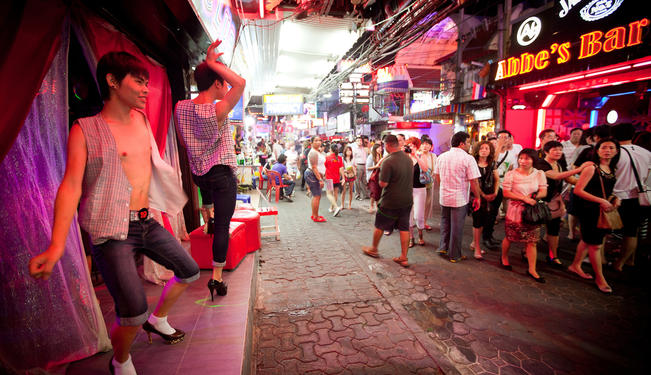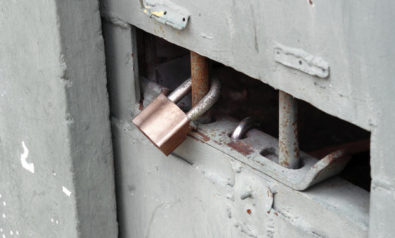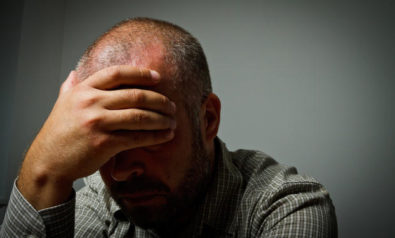An often overlooked component of the sex industry in Asia is the male sex trade.
Two weeks ago, “M” walked through Urban Light’s drop-in center doors after being introduced to the organization the prior evening. Urban Light conducts weekly outreach efforts in bars throughout Chiang Mai to let male sex workers know about the services and opportunities we provide, such as healthcare, education, meals, transitional housing, and individual care.
At the age of 16, M’s mother sent him to the city to find work and help provide for his family, including his two younger brothers. However, M is Thai Yai, one of the more than ten hill tribes of northern Thailand. His darker skin, dialect, and lack of proper government paperwork make him ineligible for almost all legal types of employment in urban areas, which is why he has ended up doing freelance sex work in bars of the Night Bazaar for the past two years.
Every night that M doesn't go home with customers, is a night he spends on the streets. M’s story is not unlike that of hundreds of other young men working in the sex industry of Chiang Mai. The migration of these boys from hill tribes, in search of economic opportunity in Thailand’s tourist centers, more often than not, adds to the growing sex industry throughout the country.
The Invisible Population
Traditional discourse on human trafficking name men as “predators” or buyers of sex, and women the “prey,” the vulnerable and at-risk population. If discussed as victims, men are usually described solely in the context of forced labor.
Unfortunately, this is a one-sided portrayal of sex trafficking. Associate Law Professor Samuel Vincent Jones poignantly highlights in his article the “conscious neglect” of men and boys in discussions of human sex trafficking. Jones points to several studies, and analyzes media coverage on the subject that emphasize a stark conclusion: men and boys are “invisible,” with emphasis given overwhelmingly to the plight of women and girls. He explains how “expressions of male dominance and invulnerability [are] perpetuated under the guise of masculinity. To some extent, men and boys have become the victims of this media-driven, socially constructed conception of maleness.”
The injustices women and girls have suffered due to trafficking is indeed of concern; however, there is a need for a shift in the conversation. Human trafficking, and sex trafficking in particular, is not just a “women and girls” issue: it is a human issue.
The work of the founder and president of Urban Light, Alezandra Russell, stemmed from her realization that NGOs and the Thai government were providing very little, if any, resources or social services to boys working in the red light district bars and massage parlors of Chiang Mai. Throughout Asia, the lack of attention to trafficked and exploited boys is astounding. The International Labor Organization’s 2012 estimate of forced labor indicates that nearly half of all certified victims of forced labor are men and boys. In a 2008 literature review of 166 scholarly publications on the global sex industry, 84 percent exclusively discussed female sex workers.
Boys working in Chiang Mai’s red light district are commonly referred to as “trash” or a “hopeless” population of street kids — a population that is not worth investing in. With social services and public funding overwhelmingly funneled to women and girls facing exploitation in Chiang Mai and abroad, the very large populations of vulnerable young men are often left with no support. A lack of opportunities and social welfare systems only perpetuates the pressure for boys to work in the high-risk, yet lucrative, sex industry. The perceived resiliency of men and boys further complicates incentive to allocate funds to this population.
Sex Tourism
On a walk down Loi Kroh Road, Chiang Mai’s main red light area, tourists or the casual passerby will see virtually no presence of male sex workers. However, tucked away in many corners of the city, male-massage parlors, go-go bars, karaoke bars, and freelance bars — establishments that do not directly employ sex workers but allow client interactions within the bar — abound.
Chiang Mai is increasingly catering to the gay community, as all of these establishments are well-advertised and described in online tourist guides. Though all gay establishments do not feed into male sexual exploitation and trafficking, some advertised on these websites do. One online publication neatly organizes establishments and warns tourists: “AT YOUR OWN RISK — the boys that hang around the Night Bazaar are freelancers; they might be cheaper than going to a go-go bar or karaoke but you have no recourse if things go wrong and they often do not have ID… Caveat Emptor.”
This statement indicates both highly and loosely organized outlets to buy sex, while acknowledging one of the most blatant reasons many men and young boys end up in the sex industry: lack of proper government identification. Advertising these bars as “host bars” also implies the availability of sex. Websites such as this claim to be for “informational” purposes only, juxtaposing this “information” with socially responsible graphics reading: “STOP the Child Sex Trade. Take Action, Report Offenders.”
Urban Light recently partnered with another world leader in the anti-trafficking movement, Love146, to conduct a study in Chiang Mai. Evaluating male sexual exploitation in the city, the study is one of the first of its kind in Thailand and examines four major sectors of the male sex industry: show bars, freelance bars, karaoke bars, and male massage parlors. Using resources such as Chiang Mai’s online gay tourist guide, the research team was able to pinpoint nearly 50 potential establishments that feed into the male sex industry of the city. Many of the establishments refused to allow employees to participate in our study, while others allowed employee participation only with management supervision.
These factors limited the results of the research. However, with just over 50 comprehensive interviews completed, Urban Light has been able to assess the plight of boys more thoroughly and better understand their circumstances. Even though this analysis paints a surface picture of what is going on in Chiang Mai and Greater Thailand, the research team has been able to lay a foundation for future research and the assessment of needs for boys.
An overwhelming majority of respondents indicated high levels of sex education, highlighting positive efforts by NGOs and government programs that target the gay community: It is commonly taken for granted that boys and young men working in the sex industry are gay. The aforementioned research data indicates, however, that there are far greater numbers of young men working in these male-catering establishments who prefer to have sex with women. Non-profits focused on catering to the LGBTQ (Lesbian-Gay-Bisexual-Transgender-Queer) community may be alienating large portions of the male sex industry, where an approach less focused on sexuality would be more effective.
Urban Light Hopes
Every year, countless young men descend upon cities all over Asia in hopes of a better future for themselves and their family, and sadly end up in a system of unsustainable income and high-risk work.
Just this past week, a former Urban Light client came to the center extremely ill. Even though he falls outside the targeted client age requirements, his frail 31-year-old body needed to be rushed to the hospital immediately. Fifteen years of sex work in Chiang Mai bars had led to positive HIV test results, which he received shortly after his arrival in the hospital. It was a tragic diagnosis, even more so because sex work continues to be this individual’s primary source of income. High risk of drug use and similar diagnoses are inevitable if no interventions are made in the male sex industry.
The male sex industry in Chiang Mai is not unlike that of many other major tourist cities of Southeast Asia. Because of a lack of enforcement of trafficking laws, corrupt police and government officials, and an overall ignorance of boys’ participation in the thriving sex industry, the problem of male sex trafficking needs to be addressed head on. Lack of access to employment, high public demand for sex, and the vulnerabilities of minority hill tribe populations make sex work a viable, last-resort option for these young men. Intervention is essential to save many of these lives. The success Urban Light has had over the past few years is a testament to the need for services and the motivation of young men to better themselves when given the opportunity.
Though a fledgling organization founded in 2010, Urban Light has tirelessly fought for the vulnerable population of boys working in the sex industry of Chiang Mai by providing transitional housing, education, healthcare, outreach, and prevention. In 2012 alone, Urban Light served more than 120 boys, with nearly a dozen participating in our transitional housing program, a path out of the sex industry. Others have found and held jobs, and one even voluntarily removed himself from Urban Light subsidized housing as he was so successful working as a waiter in a popular local restaurant. Everyday, Urban Light’s drop in center takes on new cases and learns more about the needs of boys working in Chiang Mai’s sex industry. With continued growth, research, and expanded outreach efforts, Urban Light looks forward to advocating for and helping many more boys in the future.
The views expressed in this article are the author's own and do not necessarily reflect Fair Observer’s editorial policy.
Image: Copyright © Shutterstock. All Rights Reserved
1 comment
Leave a comment
You must be logged in to post a comment.
Support Fair Observer
We rely on your support for our independence, diversity and quality.
For more than 10 years, Fair Observer has been free, fair and independent. No billionaire owns us, no advertisers control us. We are a reader-supported nonprofit. Unlike many other publications, we keep our content free for readers regardless of where they live or whether they can afford to pay. We have no paywalls and no ads.
In the post-truth era of fake news, echo chambers and filter bubbles, we publish a plurality of perspectives from around the world. Anyone can publish with us, but everyone goes through a rigorous editorial process. So, you get fact-checked, well-reasoned content instead of noise.
We publish 2,500+ voices from 90+ countries. We also conduct education and training programs
on subjects ranging from digital media and journalism to writing and critical thinking. This
doesn’t come cheap. Servers, editors, trainers and web developers cost
money.
Please consider supporting us on a regular basis as a recurring donor or a
sustaining member.
Will you support FO’s journalism?
We rely on your support for our independence, diversity and quality.











June 27, 2015
Well, you have my sympathy. I knew about this problem as far back as the early 1990's, when I was US vice consul in Bangkok under my real name. But don't expect much help from the USA at this point. We've declared homosexual expression a "right", and have put Harvey Milk, who preyed on teenaged runaways, on a postage stamp.